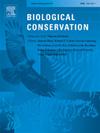Open-source, environmentally dynamic machine learning models demonstrate behavior-dependent utilization of mixed-use landscapes by jaguars (Panthera onca)
IF 4.9
1区 环境科学与生态学
Q1 BIODIVERSITY CONSERVATION
引用次数: 0
Abstract
Understanding how wide-ranging animals, such as large carnivores, respond to a dynamic environment is central to landscape and movement ecology and critical for applied conservation scenarios (e.g., landscape connectivity). Historically, however, analyses have predominantly been restricted to local areas and/or small sample sizes, used temporally static layers, and/or not accounted for unique behavioral states (e.g., resting, foraging, exploring) that drive patterns of individual movement. These limitations bound the applicability of current models – particularly for landscape connectivity-based conservation objectives, which require understanding of exploratory or dispersal movement behavior to maintain genetic diversity between geographically isolated populations. Here, we use multiple machine learning techniques and dynamic environmental data to develop behavior-specific resource selection functions for jaguars (Panthera onca) throughout a large portion of their range. We use Hidden Markov Models to classify individual telemetry data into resting, local, or exploratory movement. Then, using dynamic environmental data, including custom-built edge metrics, we employ Random Forest to model the responses of all individuals to the environment while in 1) all movement states, 2) resting and local movement, and 3) exploratory movement. Individuals in the exploratory state demonstrated several responses that deviate substantially from the current understanding of this species' movement ecology. Specifically, compared to resting/local movement, jaguars in the exploratory state were more likely to move through anthropogenic areas, low tree cover, and areas farther from high tree cover. As similar, less risk-averse behavior has been reported in other carnivores during larger scale movements such as dispersal, these exploratory movement patterns may be a proxy for dispersal movement tendencies and thus more applicable for connectivity planning for jaguars, particularly in mixed-use landscapes. The data and modeling framework are derived entirely open-source and may be applied broadly to further behavior-specific movement ecology, dynamic landscape ecology, and associated conservation scenarios.
求助全文
约1分钟内获得全文
求助全文
来源期刊

Biological Conservation
环境科学-环境科学
CiteScore
10.20
自引率
3.40%
发文量
295
审稿时长
61 days
期刊介绍:
Biological Conservation is an international leading journal in the discipline of conservation biology. The journal publishes articles spanning a diverse range of fields that contribute to the biological, sociological, and economic dimensions of conservation and natural resource management. The primary aim of Biological Conservation is the publication of high-quality papers that advance the science and practice of conservation, or which demonstrate the application of conservation principles for natural resource management and policy. Therefore it will be of interest to a broad international readership.
 求助内容:
求助内容: 应助结果提醒方式:
应助结果提醒方式:


